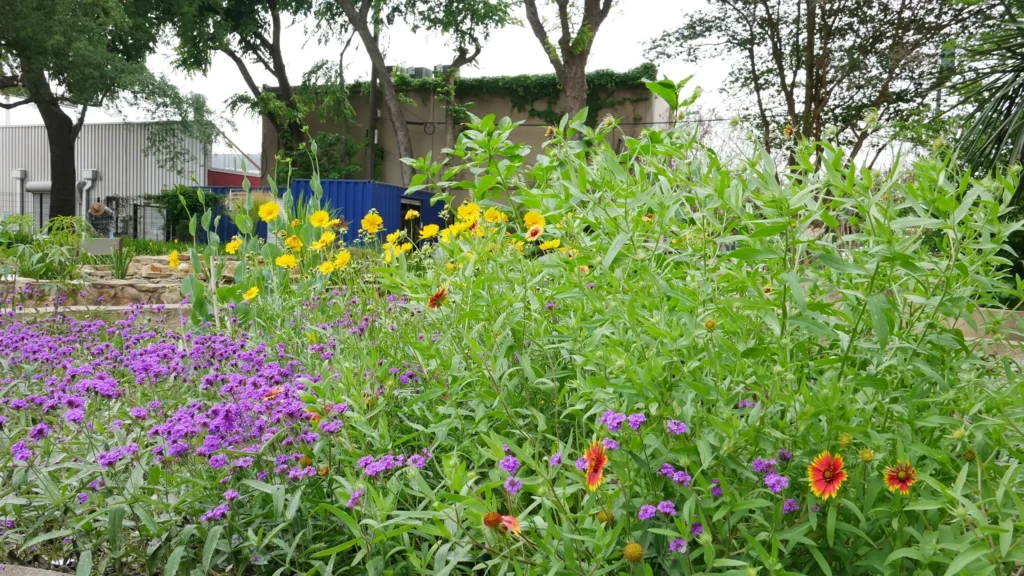Standing in the doorway to the opening of “SPRAWL,” Houston Center for Contemporary Craft’s newest group exhibition, is no different than standing at the opening of a toystore, only here you’re more likely to find a tool box filled with woodchips than a toy box full of Barbie dolls. Enter into a bejeweled wonderland of gleaming stalactites hanging from the ceiling, miniature houses teetering on seesaws and stained glass windows swinging from metal poles.
Showing at the Houston Center for Contemporary Craft, SPRAWL explores the tenuous relationship with Houston geography, at once loved and loathed by citizens and non-citizens alike for its far reach and uneven plain. Co-curated by Susie J. Silbert and Anna Walker, the exhibit stretches throughout HCCC’s gallery, mimicking the something here, something there, pockets of nothing design of the Bayou City. Additionally, the 16 artists that lent their creative hands to the exhibition provide works drastically different from one another. Like Houston’s diverse cultures, cuisines, zip codes gnashed into one “sprawling” space, this clash of craftsmen works.
The exhibition is divided into three sections: “Infrastructure of Expansion,” “Survey, Plan, Build” and “Aftereffects.” Heading up the first section are the beautiful black-and-white stalactite structures by Norwood Viviano. Viviano’s “Cities: Departure and Deviation” (2011) which illustrates population growth of 24 cities from 1850 to 2010. The illustration is done using blown glass cylinders of different heights, lengths and circumferences that hang from black rods attached to HCCC’s ceiling. Each circumference is different, based on the population of the respective city, as is the distribution of black and/or white coloring. Most of the cylinders start out black at the bottom, then become white to represent a city’s population growth over time.On the wall, a graphical representation of each city’s growth is outlined in a grayish vinyl, an excellent explanation of percentage growth for the mathematically-challenged.
In the very center of “Cities,” an all-white cylinder represents the city of Houston. In 1850, the city had only 2,396 residents. In 2010, that number skyrocketed to more than two million residents — 2,099,451, to be exact.
Nancy Nicholson’s “Construction #3” (2008) and “Construction #4” (2008) uses an unusual substance to depict the “Survey, Plan, Build” section: stained glass. These two sheets of stained glass, hanging from four metal rods, are created with Nicholson’s own photographs, which she then converts using “medieval glass techniques” of drawing and glass cutting. The two images are of a mundane construction site. Men in hard hats and overalls sit on cranes. Normally, it would be a very boring scene, but the encrusted glass, art in and of itself, livens it up.
“In general I am trying to convey a sense of beauty in what is typically perceived of as ugly or unappealing,” says Nicholson.
The theme of work and play is abundant throughout “SPRAWL.” Dustin Farnsworth combines playhouse and seesaw for “Looming Genes and Rooted Dreams,” while Paul Sacaridiz’s “An Incomplete Articulation” (2011) is construction site meets jungle gym.
“I chose working with the iconographic playground equipment in hopes of taking the viewer back to a place from their past, creating them a spot visually to place themselves in the piece, opposite the house. That imagery is heavy laden with our own experiences surrounding those objects, beckoning to to a time before the weight and thoughts of adult life and maturity,” says Farnsworth. In the same tradition, orange-and-green soccer balls lay haphazardly to the side of the wooden work benches in Sacaridiz’s towering structure — the discarded toys of children playing near an unwieldy stack of wooden planks nod to a decision to put away childish things in favor of growth.
In Julia Gabriel’s art, the “Aftereffects” of expansion and building is a chic metropolis, depicted in the form of six leather backpacks. These are not any backpacks, though, and this is not any metropolis. Lined up side-by-side, they represent “Congress @ Bastrop, Houston, Texas” (2013). The actual street is a lineup of old buildings, and, lined up side-by-side, the staid color and clunkiness of these six backpacks copy the original. On the far left, two beige backpacks are outlined in red and white trim. On the right, one lone brown backpack gets a spot. In the middle, three blue backpacks outlined in white trim stand tall — wearable mini-models of the dilapidated, graffiti-laced behemoths that sit dejectedly on Congress today.
“SPRAWL” will be on view through January 19, 2014. There will be a number of talks related to the exhibition. Visit crafthouston.org for more information.
